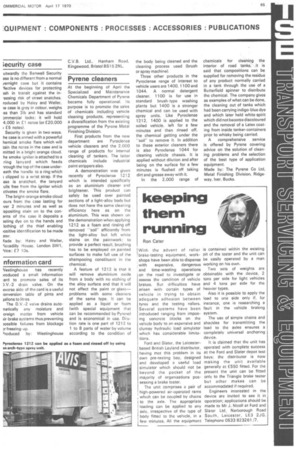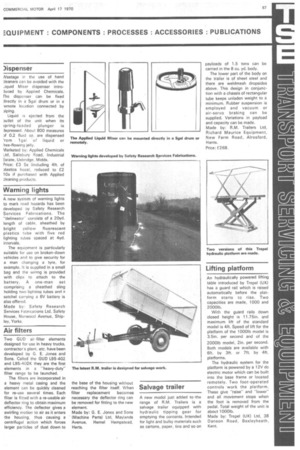keeping them them running
Page 67

Page 69

If you've noticed an error in this article please click here to report it so we can fix it.
Ron Cater With the advent of roller brake-testing equipment, work. shops have been able to dispense with expensive, dangerous and time-wasting operations on the road to investigate or assess the condition of vehicle brakes. But difficulties have arisen With certain types of vehicle in trying to obtain adequate adhesion between tyres and the testing rollers. Several systems have been introduced ranging from imposing concrete blocks on the vehicle body to an expensive and clumsy hydraulic load simulator which has considerable limitations.
Ford and Slater, the Leicesterbased British Leyland distributor, having met this problem in its own pre-testing bay, designed and developed a useful load simulator which should not be beyond the pocket of the majority of organizations possessing a brake tester.
The unit comprises a pair of high-powered air-operated rams which can be coupled by chains to the axle. The appropriate loading can be applied to any axle, irrespective of the type of body fitted to the vehicle, in a few minutes. All the equipment
is contained within the existing pit of the tester and the unit can be easily operated by a man working on his own.
Two sets of weights are obtainable with the device, 2 tons per side for light vehicles and 4 tons per side for the heavier types.
Also it is possible to apply the load to one side only if, for instance, one is researching a fault in the vehicle braking system.
The use of simple chains and shackles for transmitting the load to the axles ensures a completely universal anchoring device.
It is claimed that the unit has operated with complete success at the Ford and Slater depot test bays; the distributor is now making the unit available generally at £550 fitted. For the present the unit can be fitted only to the Triangle brake tester but other makes can be accommodated if required.
Engineers interested in the device are invited to see it in operation; applications should be made to Mr J. Nicoll at Ford and Slater Ltd, Narborough Road South, Leicester, LE3 2JG. Telephone 0533 823261 /7.
)ispenser
Nastage in the use of hand :leaners can be avoided with the .iquid Miser dispenser introAuced by Applied Chemicals. ihe dispenser can be fixed lirectly in a 5gal drum or in a .emote location connected by Liquid is ejected from the Putlet of the unit when its Tring-loaded plunger is iepressed. About 800 measures A 0.2 fluid oz. are dispensed 'torn lgal of liquid or 'ree-flowing jelly.
Marketed by: Applied Chemicals Ltd, Salisbury Road, Industrial Estate, Uxbridge, Middx, Price: £3 5s (including 4ft. of plastics hose), reduced to £2 10s if purchased with Applied :leaning products.
Warning lights
A new system of warning lights to mark road hazards has been developed by Safety Research Services Fabrications. The "delineator' consists of a 20yd. length of cable, sheathed by bright yellow fluorescent plastics tube with five red lighting tubes spaced at 4yd. intervals.
The equipment is particularly suitable for use on broken-down vehicles and to give security for a man changing a tyre, for example. It is supplied in a small bag and the wiring is provided with clips to attach to the battery. A one-man set comprising a sheathed sling holding two lighting tubes and A satchel carrying a 6V battery is also offered.
Made by: Safety Research Services Fabrications Ltd, Safety House, Norwood Avenue, Shipley, Yorks.
Air filters
Two GUD air-filter elements designed for use in heavy trucks, contractor's plant, etc, have been developed by G. E. Jones and Sons. Called the GUD L95-402 and L95-402K they are the first elements in a "heavy-duty" filter range to be launched.
The filters are incorporated in a heavy metal casing and the element can be quickly cleaned for re-use several times. Each filter is fitted with a re-usable air deflector ring to obtain maximum efficiency. The deflector gives a swirling motion to air as,it enters the housing, thus causing a centrifugal action which forces larger particles of dust down to the base of the housing without reaching the filter itself. When filter replacement becomes necessary the deflector ring can be removed for fitting to the new element.
Made by: G. E. Jones and Sons (Machine Parts) Ltd, Maylands Avenue, Hemel Hempstead, Herts.
Salvage trailer
A new model just added to-the range of R.M. Trailers is a salvage trailer equipped with hydraulic tipping gear for emptying the contents. Intended for light and bulky materials such as cartons, paper, tins and so on payloads of 1.5 tons can be carried in the 8 cu. yd. body.
The lower part of the body on the trailer is of sheet steel and there are weldmesh dropsides above. This design in conjunction with a chassis of rectangular tube keeps unladen weight to a minimum. Rubber suspension is employed and vacuum or air-servo braking can be supplied. Variations in payload and capacity can be made.
Made by: R.M. Trailers Ltd, Richard Maurice Equipment, New Farm Road, Alresford, Hants.
Price: £268.
Lifting platform
An hydraulically powered lifting table introduced by Trepel (UK) has a guard rail which is raised automatically before the platform starts to rise. Two capacities are made, 1000 and 20001b.
With the guard rails down closed height is 11.75in. and maximum lift of the standard model is 4ft. Speed of lift for the platform of the 1000lb model is 3.5in. per second and of the 20001b model, 2in. per second. Both models are available with 6ft. by 3ft. or 7ft. by 4ft. platforms.
The hydraulic system for the platform is powered by a 12V dc electric motor which can be built into the base frame or located remotely. Two foot-operated controls work the platform. These give "raise" and "lower" and all movement stops when the foot is removed from the pedal. Total weight of the unit is about 10001b.
Made lay: Trepel (UK) Ltd, 38 Denson Road, Bexleyheath, Kent.












































































































